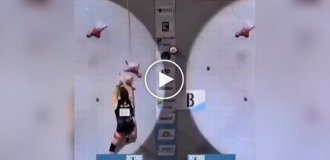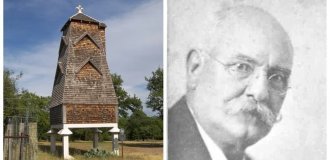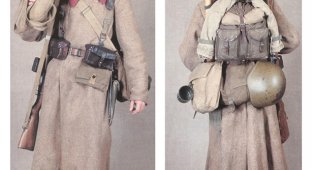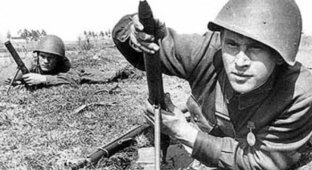Uniform and equipment of a victorious soldier
On the left is a Red Army soldier in 1941. On the right is a soldier of the Soviet Army in 1945

Steel helmet SSH-40. This helmet is a modernization of the SSh-39 helmet, accepted for supply to the Red Army in June 1939. The design of the SSh-39 eliminated the shortcomings of the previous SSh-36, but the operation of the SSh-39 during the Soviet-Finnish war of 1939–1940. revealed a significant drawback - it was impossible to wear a winter hat under it, and the standard woolen balaclava did not protect against severe frosts. Therefore, soldiers often broke out the SSh-39 under-the-shoulder device and wore a helmet over their hat without it.
As a result, in the new SSh-40 helmet, the under-helmet device was significantly different from the SSh-39, although the shape of the dome remained unchanged. Visually, the SSh-40 can be distinguished by six rivets around the circumference at the bottom of the helmet dome, while the SSh-39 has three rivets, and they are located at the top. The SSh-40 used an under-body device of three petals, to which shock absorber bags stuffed with industrial cotton wool were sewn on the reverse side. The petals were tightened with a cord, which made it possible to adjust the depth of the helmet on the head.
Production of the SSh-40 began at the beginning of 1941 in Lysva in the Urals, and a little later in Stalingrad at the Red October plant, but by June 22, the troops had only a small number of these helmets. By the fall of 1942, helmets of this type were made only in Lysva. Gradually, the SSh-40 became the main type of helmet for the Red Army. It was produced in large quantities after the war, and was withdrawn from service relatively recently.

The pot is round. A bowler hat of a similar round shape was used in the army of the Russian Empire, made from copper, brass, tinned tin, and later from aluminum. In 1927, in Leningrad, at the Krasny Vyborzhets plant, mass production of round-shaped stamped aluminum pots for the Red Army was launched, but in 1936 they were replaced by a new type of flat pot.
With the beginning of the Great Patriotic War, in the fall of 1941, the production of round pots was again established in Lysva in the Urals, but from steel instead of scarce aluminum. The return to a round shape was also understandable - such a pot was easier to produce. The Lysvensky plant has done a lot of work, which has made it possible to significantly reduce production costs. By 1945, the total production of round army bowlers amounted to more than 20 million pieces - they became the most popular in the Red Army. Production continued after the war.

Duffel bag. This piece of equipment, nicknamed “sidor” by the soldiers, was a simple bag with a strap and a rope tie at the neck. It first appeared in the Tsarist army in 1869 and, without significant changes, ended up in the Red Army. In 1930, a new standard was adopted that determined the appearance of the duffel bag - in accordance with it, it was now called the “Turkestan type duffel bag”, or duffel bag of the 1930 model.
The duffel bag had only one compartment, the top of which could be pulled together with a rope. A shoulder strap was sewn to the bottom of the bag, onto which two jumpers were placed, intended for fastening on the chest. On the other side of the shoulder strap, three rope loops were sewn to adjust the length. A wooden brake boss was sewn to the corner of the bag, to which the loop of the shoulder strap clung. The shoulder strap was folded into a “cow” knot, into the center of which the neck of the bag was threaded, after which the knot was tightened. In this form, the bag was put on and carried behind the fighter’s back.
In 1941, there was a change in the appearance of the duffel bag of the 1930 model: it became slightly smaller, the shoulder strap was narrower and received a lining inside on the shoulders, which required stitching. In 1942, a new simplification followed - the lining in the shoulder strap was abandoned, but the strap itself was made wider. The duffel bag was produced in this form until the end of the 40s. Taking into account the ease of manufacture, the duffel bag became the main means for carrying personal belongings of Red Army soldiers during the Great Patriotic War.

Gas mask bag, model 1939. By 1945, no one removed the gas mask from the supplies of the Red Army soldiers. However, four years of the war passed without chemical attacks, and the soldiers tried to get rid of the “unnecessary” piece of equipment by handing it over to the convoy. Often, despite the constant control of the command, gas masks were simply thrown away, and personal belongings were carried in gas mask bags.
Gas mask bag, model 1939. By 1945, no one removed the gas mask from the supplies of the Red Army soldiers. However, four years of the war passed without chemical attacks, and the soldiers tried to get rid of the “unnecessary” piece of equipment by handing it over to the convoy. Often, despite the constant control of the command, gas masks were simply thrown away, and personal belongings were carried in gas mask bags.
During the war, soldiers of even the same unit could have different bags and gas masks of different types. The photo shows a gas mask bag of the 1939 model, released in December 1941. The bag, made of tent fabric, closed with a button. It was much easier to make than the 1936 bag.

Small infantry shovel. During the war, the MPL-50 small infantry shovel underwent a number of changes aimed at simplifying production. At first, the overall design of the tray and shovel remained unchanged, but the fastening of the lining with the back strand began to be done by spot electric welding instead of rivets; a little later they abandoned the crimp ring, continuing to fasten the handle between the strands on rivets.
In 1943, an even more simplified version of the MPL-50 appeared: the shovel became all-stamped. It abandoned the lining with the rear cord, and the shape of the upper part of the front cord became flat (before it was triangular). Moreover, now the front cord began to twist, forming a tube, held together by rivets or welding. The handle was inserted into this tube, driven tightly until it was wedged with a shovel tray, after which it was fixed with a screw. The photo shows a shovel of intermediate series - with cords, without a crimp ring, with the lining fastened by spot electric welding.

Pomegranate bag. Each infantryman carried hand grenades, which were normally carried in a special bag on the waist belt. The bag was located on the left back, after the cartridge bag and in front of the grocery bag. It was a rectangular fabric bag with three compartments. The two large ones contained grenades, the third, small one - detonators for them. The grenades were brought into firing position immediately before use. The material of the bag could be canvas, canvas or tent fabric. The bag was closed with a button or a wooden clamp.
The bag contained two old grenades of the 1914/30 model or two RGD-33 (pictured), which were placed with the handles up. The detonators were in paper or rags. Also, four F-1 lemons could be placed in pairs in the bag, and they were located in a unique way: on each grenade, the ignition socket was closed with a special screw plug made of wood or bakelite, while one grenade was placed with the plug down, and the second up. With the adoption of new types of grenades during the war by the Red Army, their placement in a bag was similar to the F-1 grenades. Without significant changes, the grenade bag served from 1941 to 1945.

Soldier's trousers, model 1935. Accepted for supply to the Red Army by the same order as the 1935 tunic, the trousers remained unchanged throughout the Great Patriotic War. They were high-waisted breeches that fit well at the waist, loose at the top and tight around the calves.
Strings were sewn along the bottom of the trousers. There were two deep pockets on the sides of the trousers, and another pocket with a flap fastened with a button was located in the back. At the belt, next to the codpiece, there was a small pocket for a mortal medallion. Pentagonal reinforcement pads were sewn onto the knees. The belt had loops for a trouser belt, although the possibility of adjusting the volume was also provided using a strap with a buckle at the back. Bloomers were made from a special double “harem” diagonal and were quite durable.

Soldier's tunic, model 1943. It was introduced by order of the People's Commissar of Defense of the USSR dated January 15, 1943 to replace the 1935 model tunic. The main differences were a soft stand-up collar instead of a turn-down collar. The collar was fastened with two small uniform buttons. The front placket was open and fastened with three buttons through through loops.
On the shoulders there were shoulder straps, for which belt loops were sewn. During wartime, the soldier's tunic did not have pockets; they were introduced later. Pentagonal field shoulder straps were worn on the shoulders in combat conditions. For infantry, the field of the shoulder strap was green, the edging along the edge of the shoulder strap was crimson. The junior command staff's stripes were sewn onto the upper part of the shoulder straps.

Belt. Due to the fact that leather was expensive to process and was often required for the manufacture of more durable and critical items of equipment, by the end of the war, the belt made of braid, reinforced with elements of leather or leather split leather, became more widespread. This type of belt appeared before 1941 and was used until the end of the war.
Many leather waist belts, differing in detail, came from the Lend-Lease allies. The American belt shown in the photo, 45 mm wide, had a single-prong buckle, like its Soviet counterparts, but it was not made of round wire, but was cast or stamped, with clear corners.
The Red Army also used captured German belts, whose buckle had to be modified because of the design with an eagle and swastika. Most often, these attributes were simply ground off, but when there was free time, the silhouette of a five-pointed star was cut into the buckle. The photo shows another modification option: a hole was punched in the center of the buckle into which a star from a Red Army cap or cap was inserted.

Scout knife HP-40. The 1940 model reconnaissance knife was adopted by the Red Army following the results of the Soviet-Finnish War of 1939–1940, when the need arose for a simple and convenient army combat knife.
Soon the production of these knives was launched by the Trud artel in the village of Vacha (Gorky Region) and at the Zlatoust Tool Plant in the Urals. Later, the HP-40 was manufactured at other enterprises, including in besieged Leningrad. Despite the same design, the HP-40 from different manufacturers differs in details.
At the initial stage of the Great Patriotic War, only intelligence officers were armed with HP-40 knives. For the infantry they were not a statutory weapon, but the closer to 1945, the more and more knives can be seen in photographs of ordinary machine gunners. Production of the HP-40 continued after the war, both in the USSR and in the countries participating in the Warsaw Pact.

Glass flask. Glass flasks were widely used in many armies of the world. The Russian Imperial Army was no exception, from which this type of flask was “inherited” by the Red Army. Despite the fact that flasks made of tin or aluminum that were produced in parallel were more practical, cheap glass containers were good for a mass conscript army.
The Red Army tried to replace glass flasks with aluminum ones, but they didn’t forget about glass either - on December 26, 1931, another standard for the production of such flasks with a nominal volume of 0.75 and 1.0 liters was approved. With the beginning of the war, glass flasks became the main thing - the shortage of aluminum and the blockade of Leningrad, where most aluminum flasks were produced, had an impact.
The flask was closed with a rubber or wooden stopper with string tied around the neck. Several types of cases were used for carrying, and almost all of them involved wearing the flask on a belt over the shoulder. Structurally, such a case was a simple bag made of fabric with rope ties at the neck. There were variants of covers with soft inserts to protect the flask during impacts - these were used in the Airborne Forces. The glass flask could also be carried in a belt pouch, adopted for aluminum flasks.

Box magazine bag. With the advent of box magazines for the Shpagin submachine gun and with the development of the Sudaev submachine gun with similar magazines, the need arose for a bag to carry them. A magazine bag for a German submachine gun was used as a prototype.
The bag contained three magazines, each of which was designed for 35 rounds. Each PPS-43 was supposed to have two such bags, but wartime photographs show that machine gunners often carried only one. This was due to a certain shortage of magazines - in combat conditions they were consumables and easily lost.
The bag was made of canvas or canvas and, unlike the German one, it was greatly simplified. The valve was fastened with pegs or wooden brake lugs; there were also options with buttons. At the back of the bag were sewn loops for threading a waist belt. Bags were worn on a belt in front, which provided quick access to equipped magazines and putting empty ones back. Laying magazines up or down with the neck was not regulated.

Yuft boots. Initially, boots were the only footwear for the Russian soldier: boots with tapes were accepted for supply only at the beginning of 1915, when the army sharply increased in numbers and boots were no longer enough. Soldiers' boots were made from yuft leather and were supplied to all branches of the military in the Red Army.
In the mid-30s, tarpaulin was invented in the USSR - a material with a fabric base, onto which artificial sodium butadiene rubber was applied to imitate the texture of leather. With the beginning of the war, the problem of supplying the mobilized army with shoes became acute, and the “damn leather” came in handy - the Red Army soldiers’ boots became tarpaulin.
By 1945, the typical Soviet infantryman was wearing kirzachi or boots with tapes, but experienced soldiers sought to get leather boots for themselves. The photo shows the infantryman wearing yuft boots, with leather soles and leather heels.

























